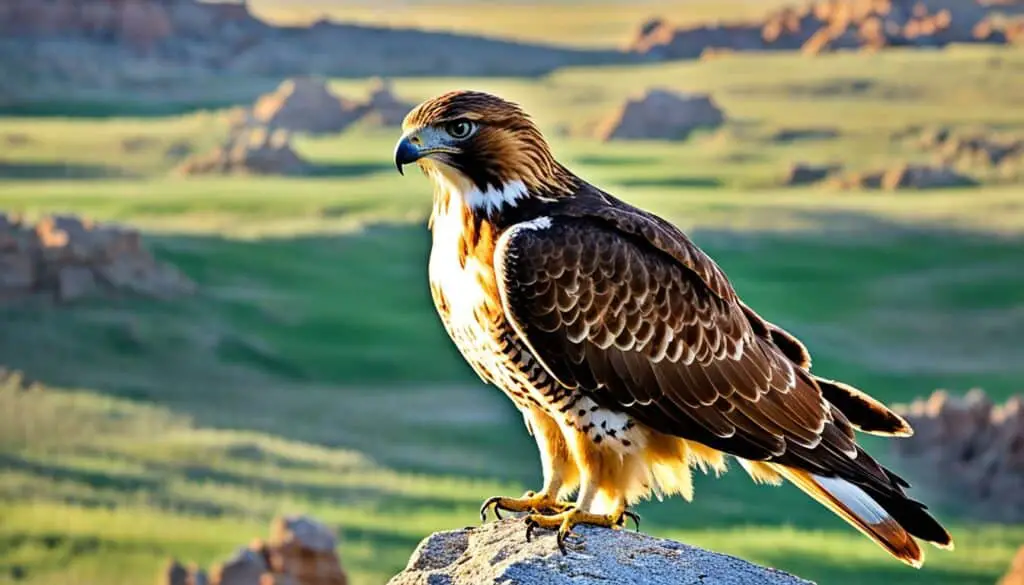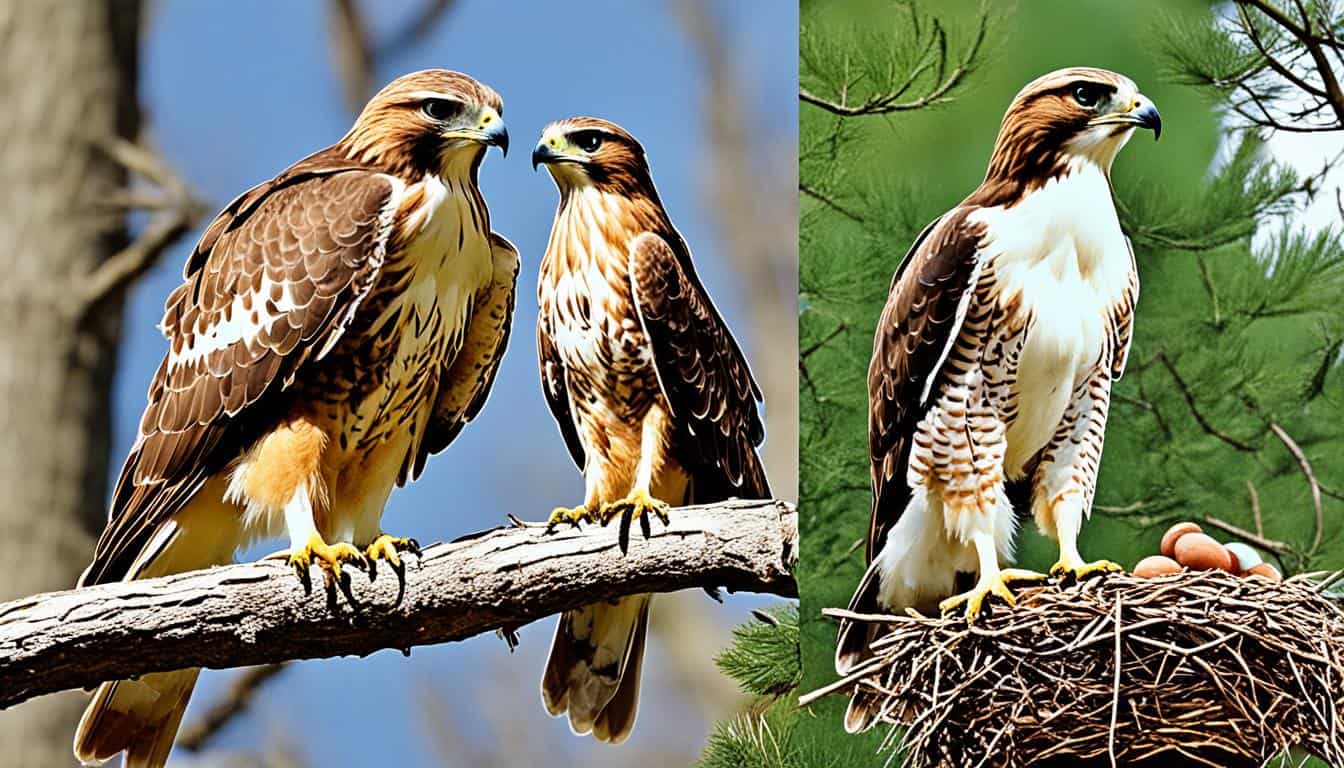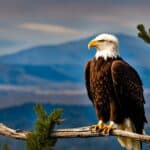Have you ever wondered how long a red-tailed hawk can live in North America’s wild lands? These magnificent birds are known for their loud calls and grand flights. Learning about their life span means we explore how they survive. This includes their health and how they face changing environments. There’s much we can learn about their survival and how long they live.
The Average Lifespan of a Red-Tailed Hawk
Understanding the lifespan of red-tailed hawks shows us how different their wild and captive lives are. This difference heavily affects how long they live.
Understanding General Life Expectancy
Red-tailed hawks in the wild usually live 10 to 15 years. This is because they must survive natural dangers. These dangers include other animals and the changing environment.
A hawk’s health, what it eats, and where it lives all matter for its lifespan.
Wild Versus Captive Lifespan
Hawks in the wild live about 10 to 15 years. But, in captivity, they can live much longer, up to 20 years or more.
This is because, in captivity, they get a steady diet and are safe from their main predators. Plus, they aren’t as threatened by people.
The differences between the lifespans of wild and captive red-tailed hawks are clear. External factors play a huge role in how long they live. This shows the complex way hawks interact with their environment.
Factors Affecting Red-Tailed Hawk Longevity
The lifespan of a red-tailed hawk changes due to many internal and external factors. It’s interesting to learn how these birds handle their risky worlds.
Predation and Natural Threats
Young red-tailed hawks face the most danger from predators. They aren’t safe from larger birds and other hunters until they can fly well. These early struggles really impact how long they live.
Environmental Factors
The life of a red-tailed hawk is greatly affected by their surroundings. Having enough food and the right place to nest is crucial. If they have the essentials they need and good weather, they can live longer. But, tough weather and not enough food can cut their life short.
Human Impact
People can shorten the lives of red-tailed hawks through things like destroying their homes. Travel dangers and pollution are also big issues. Places with a lot of buildings and activities put these birds at more risk. It’s important to work on protecting them to help them live longer.
| Factor | Impact on Longevity |
|---|---|
| Predation | High for Juveniles |
| Environmental Factors | Variable |
| Human Impact | Negative in Urban Areas |
Red-Tailed Hawk Lifecycle: From Hatchling to Adult
The journey of a red-tailed hawk from birth to adulthood is amazing. It’s full of interesting growth stages. These birds face many hard experiences but also learn essential skills for living in the wild.
Stages of Growth
Red-tailed hawks begin life as hatchlings. They are born needing their parents for food and safety. Quickly, they grow and start to discover their world. They learn skills like flying, which are very important. But, they are also at risk from bigger animals and dangers around them.
Juvenile to Mature Hawk
As young hawks grow up, they change a lot. Juveniles learn to hunt and protect their space. This is a hard but important part of their growth. Adults continue this journey, using their skills to find a home and a mate. This cycle helps the hawk population grow.
The story from a weak hatchling to a strong adult is a key part of their life. It shows their power to overcome tough situations. Each step in their journey is critical for their future.
Survival Rate of Red-Tailed Hawks in the Wild
The survival rate of red-tailed hawks catches the interest of many, from bird fans to scientists. It’s important to learn about the hard early life of these hawks. This helps us see why they are so strong and able to adapt. Sadly, many young hawks face danger early on, which decides their future. But, they have special ways to survive in the wild.
Early Mortality Rates
Baby red-tailed hawks are in danger right from the start. They have to deal with predators, bad weather, and not enough food. These threats make it hard for most of them to live past their first year. The risk of their nests being invaded and not having enough food are major reasons why so many die early. This heavily affects the red-tailed hawk survival rate.
Survival Strategies
Even with big challenges, red-tailed hawks have smart ways to survive. Their amazing eyesight and strong claws help them hunt well. This improves their chances of getting food. They are also great at flying without using a lot of energy. This helps them get away from dangers and save energy. Defending their space helps them have enough resources and safe places to live. These red-tailed hawk survival strategies are key for their success in the wild.
Historical Longevity Records of Red-Tailed Hawks
Some red-tailed hawks have lived for a really long time. They’ve broken age records, showing us new things about their lifespan. This helps us know more about these grand birds.
Oldest Recorded Red-Tailed Hawks
The oldest red-tailed hawks have reached impressive ages. For example, a wild one hit 30 years and 8 months in Michigan. This signals their amazing resilience when conditions are right.
Case Study: Charlie the Red-Tailed Hawk
Let’s look at Charlie the Red-Tailed Hawk as an example. He was at Washington State University and lived past 30.9 years. Charlie’s story shows how great care and a bit of luck can make a big difference.
| Hawk Name | Location | Age |
|---|---|---|
| Wild Hawk | Michigan | 30 years, 8 months |
| Charlie the Red-Tailed Hawk | Washington State University | Over 30.9 years |
These stories highlight the potential for long life in red-tailed hawks. Factors like care, luck, and the environment all play a part in their longevity.
Typical Habitats of Red-Tailed Hawks and Their Influence on Lifespan
Red-tailed hawks live in diverse places throughout North America. They can be found in arid deserts, lush grasslands, and urban areas. Each of these environments affects their lifespan in different ways.

Access to food is key for a hawk’s survival and long life. Grasslands are great for finding small mammals to eat. This is important because these mammals are a big part of a hawk’s diet. But, living in urban areas means they can find food scraps easily. Yet, it also brings dangers like more chances of hitting cars and pollution.
Nesting spots in these environments are also very important. Locations with lots of trees or cliffs are excellent for nesting. They provide protection from predators and bad weather. On the other hand, places without these protective features can be risky for hawks. This might make their lives shorter.
Another big factor is how much a hawk’s home places them at risk from the environment. Hawks in rural areas face less threat from people. But, those in cities deal with more danger, like cars and pollution. These dangers affect their health and how long they live.
| Habitat Type | Key Features | Influence on Lifespan |
|---|---|---|
| Deserts | Scarce vegetation, abundant small reptiles | Moderate lifespan due to limited food sources |
| Grasslands | Rich in small mammals and other prey | Increased lifespan with ample food supply |
| Urban Environments | High human activity, mixed food availability | Variable lifespan with potential for both high risks and rewards |
| Forests | Dense tree cover, high prey diversity | Higher lifespan with secure nesting and food access |
Nutritional Requirements and Their Role in Longevity
The red-tailed hawk’s diet is key to its survival and health. It eats small mammals like rodents and rabbits in the wild. This diet meets most of their nutritional needs.
Natural Diet in the Wild
Red-tailed hawks mainly eat small mammals. These include voles, mice, and squirrels. They can also hunt birds, reptiles, and insects. This varied diet ensures they get all the nutrients they need to live.
Nutritional Challenges
Red-tailed hawks can face food shortages. This happens when the number of prey animals drops, or human actions change their environment. They need good nutrition for growth, reproduction, and a strong immune system. Their diet’s quality affects how long they can live.
| Diet Component | Primary Nutrient | Significance |
|---|---|---|
| Small Mammals | Proteins | Essential for muscle development and energy |
| Birds | Amino Acids | Important for cellular repair and growth |
| Reptiles | Vitamins and Minerals | Supports bone health and metabolic functions |
| Insects | Fats | Provides additional energy reserves |
Knowing what red-tailed hawks eat shows how important steady food is. It’s key for their survival and well-being.
Adaptive Behaviors That Enhance Red-Tailed Hawk Survival
Learning about red-tailed hawks’ skills helps us see how they live well in different places. They are good at hunting and staying safe. This helps them do well in nature. Their skills have grown over time, making them strong and successful in North America.
Hunting Techniques
Red-tailed hawks have special ways of hunting. They often sit high up to look for prey. Their great eyesight helps them see well from far away. When they see something to eat, they dive down fast and grab it. This way of hunting helps them use less energy and catch their food easily.
Soaring and Territory Defense
Soaring saves red-tailed hawks energy when they search for food. Their wings let them float in the air for a long time. This is also important for defending their home area. They fight off others to keep their food and homes safe. Their fights in the air warn away other birds, so they stay in charge of their area.
Their evolved behaviors show how good they are at living in many places. Knowing about their skills teaches us about their ability to change and survive. It also shows how their actions help them live well in the wild.
FAQ
What is the lifespan of a red-tailed hawk in the wild?
In the wild, a red-tailed hawk often lives 10 to 15 years. The time they live depends on what they eat, the weather, and what people do.
How does the lifespan of red-tailed hawks in captivity compare to those in the wild?
Hawks that live with people can live over 20 years. They eat controlled diets and don’t have to worry about other animals eating them. They also get medical care.
What are the main factors that affect the longevity of red-tailed hawks?
Things that can hurt them like not having enough food, where they live, and people messing with their homes affect how long they live.
What stages are involved in the lifecycle of a red-tailed hawk?
Red-tailed hawks start as hatchlings, then become juveniles, and finally adults. They learn how to hunt and protect their space at each stage.
What is the survival rate of red-tailed hawks in their first year?
Young hawks don’t live very long. They often die because they can’t find enough food or they get hurt.
Who are some of the oldest recorded red-tailed hawks?
A hawk in Michigan lived over 30 years. There’s also Charlie from Washington State University who is over 30.9 years old.
How do different habitats influence the lifespan of red-tailed hawks?
Hawks live in many places like deserts and cities. Where they live changes how well they can eat and stay safe. This affects how long they live.
What does the natural diet of a red-tailed hawk include, and how does it affect their longevity?
Hawks mostly eat small animals. Finding these animals affects how healthy and long they live.
What adaptive behaviors do red-tailed hawks exhibit to enhance their survival?
They are good at hunting, fly in a way to save energy, and protect their homes. These things help them do well in different places.







